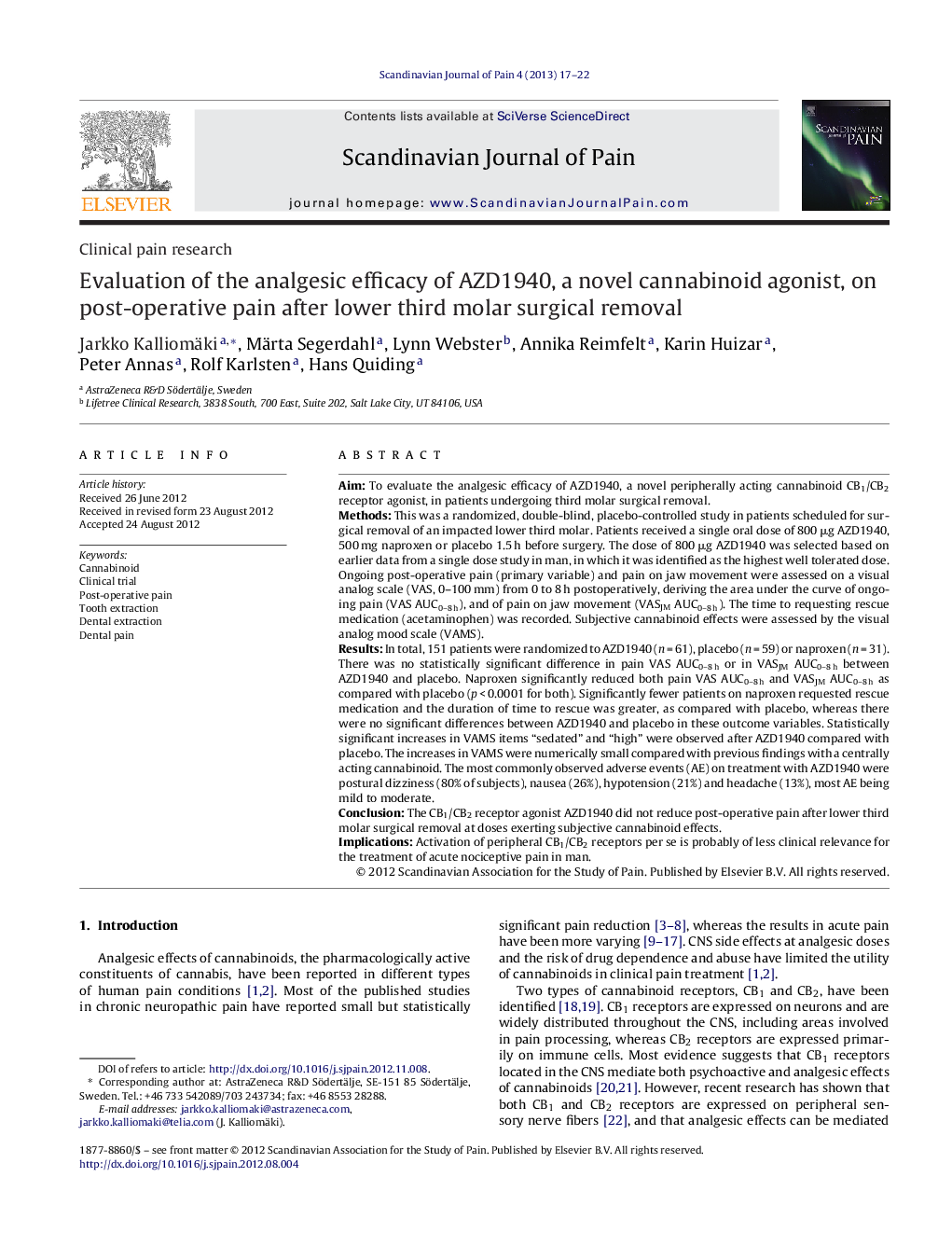| کد مقاله | کد نشریه | سال انتشار | مقاله انگلیسی | نسخه تمام متن |
|---|---|---|---|---|
| 2770794 | 1567822 | 2013 | 6 صفحه PDF | دانلود رایگان |

AimTo evaluate the analgesic efficacy of AZD1940, a novel peripherally acting cannabinoid CB1/CB2 receptor agonist, in patients undergoing third molar surgical removal.MethodsThis was a randomized, double-blind, placebo-controlled study in patients scheduled for surgical removal of an impacted lower third molar. Patients received a single oral dose of 800 μg AZD1940, 500 mg naproxen or placebo 1.5 h before surgery. The dose of 800 μg AZD1940 was selected based on earlier data from a single dose study in man, in which it was identified as the highest well tolerated dose. Ongoing post-operative pain (primary variable) and pain on jaw movement were assessed on a visual analog scale (VAS, 0–100 mm) from 0 to 8 h postoperatively, deriving the area under the curve of ongoing pain (VAS AUC0–8 h), and of pain on jaw movement (VASJM AUC0–8 h). The time to requesting rescue medication (acetaminophen) was recorded. Subjective cannabinoid effects were assessed by the visual analog mood scale (VAMS).ResultsIn total, 151 patients were randomized to AZD1940 (n = 61), placebo (n = 59) or naproxen (n = 31). There was no statistically significant difference in pain VAS AUC0–8 h or in VASJM AUC0–8 h between AZD1940 and placebo. Naproxen significantly reduced both pain VAS AUC0–8 h and VASJM AUC0–8 h as compared with placebo (p < 0.0001 for both). Significantly fewer patients on naproxen requested rescue medication and the duration of time to rescue was greater, as compared with placebo, whereas there were no significant differences between AZD1940 and placebo in these outcome variables. Statistically significant increases in VAMS items “sedated” and “high” were observed after AZD1940 compared with placebo. The increases in VAMS were numerically small compared with previous findings with a centrally acting cannabinoid. The most commonly observed adverse events (AE) on treatment with AZD1940 were postural dizziness (80% of subjects), nausea (26%), hypotension (21%) and headache (13%), most AE being mild to moderate.ConclusionThe CB1/CB2 receptor agonist AZD1940 did not reduce post-operative pain after lower third molar surgical removal at doses exerting subjective cannabinoid effects.ImplicationsActivation of peripheral CB1/CB2 receptors per se is probably of less clinical relevance for the treatment of acute nociceptive pain in man.
► AZD1940 is a novel peripherally acting cannabinoid CB1/ CB2 receptor agonist.
► Analgesic efficacy was studied in post-operative pain after 3rd molar removal.
► AZD1940 was no better than placebo in relieving post-operative pain.
► Naproxen reduced pain better than placebo, i.e. study had adequate sensitivity.
► Activation of peripheral CB1/CB2 receptors did not relieve acute nociceptive pain.
Journal: Scandinavian Journal of Pain - Volume 4, Issue 1, January 2013, Pages 17–22